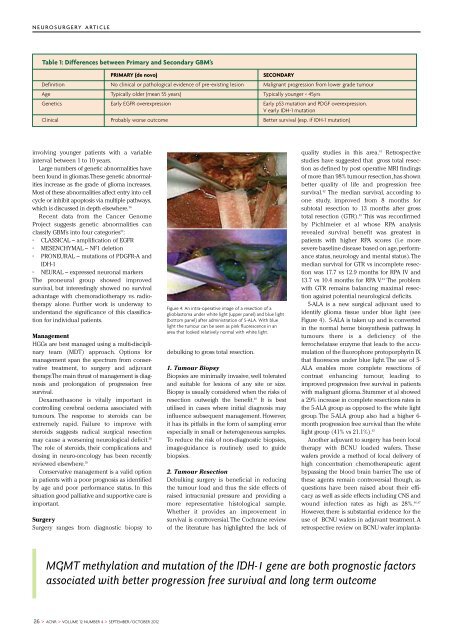Download - Advances in Clinical Neuroscience and Rehabilitation
Download - Advances in Clinical Neuroscience and Rehabilitation
Download - Advances in Clinical Neuroscience and Rehabilitation
- No tags were found...
You also want an ePaper? Increase the reach of your titles
YUMPU automatically turns print PDFs into web optimized ePapers that Google loves.
N E U RO S U RG E RY A RT I C L ETable 1: Differences between Primary <strong>and</strong> Secondary GBM’sPRIMARY (de novo)SECONDARYDef<strong>in</strong>ition No cl<strong>in</strong>ical or pathological evidence of pre-exist<strong>in</strong>g lesion Malignant progression from lower grade tumourAge Typically older (mean 55 years) Typically younger < 45yrsGenetics Early EGFR overexpression Early p53 mutation <strong>and</strong> PDGF overexpression.V early IDH-1 mutationCl<strong>in</strong>ical Probably worse outcome Better survival (esp. if IDH-1 mutation)<strong>in</strong>volv<strong>in</strong>g younger patients with a variable<strong>in</strong>terval between 1 to 10 years.Large numbers of genetic abnormalities havebeen found <strong>in</strong> gliomas. These genetic abnormalities<strong>in</strong>crease as the grade of glioma <strong>in</strong>creases.Most of these abnormalities affect entry <strong>in</strong>to cellcycle or <strong>in</strong>hibit apoptosis via multiple pathways,which is discussed <strong>in</strong> depth elsewhere. 36Recent data from the Cancer GenomeProject suggests genetic abnormalities canclassify GBM’s <strong>in</strong>to four categories 37 :• CLASSICAL – amplification of EGFR• MESENCHYMAL – NF1 deletion• PRONEURAL – mutations of PDGFR-A <strong>and</strong>IDH-1• NEURAL – expressed neuronal markersThe proneural group showed improvedsurvival, but <strong>in</strong>terest<strong>in</strong>gly showed no survivaladvantage with chemoradiotherapy vs. radiotherapyalone. Further work is underway tounderst<strong>and</strong> the significance of this classificationfor <strong>in</strong>dividual patients.ManagementHGGs are best managed us<strong>in</strong>g a multi-discipl<strong>in</strong>aryteam (MDT) approach. Options formanagement span the spectrum from conservativetreatment, to surgery <strong>and</strong> adjuvanttherapy. The ma<strong>in</strong> thrust of management is diagnosis<strong>and</strong> prolongation of progression freesurvival.Dexamethasone is vitally important <strong>in</strong>controll<strong>in</strong>g cerebral oedema associated withtumours. The response to steroids can beextremely rapid. Failure to improve withsteroids suggests radical surgical resectionmay cause a worsen<strong>in</strong>g neurological deficit. 38The role of steroids, their complications <strong>and</strong>dos<strong>in</strong>g <strong>in</strong> neuro-oncology has been recentlyreviewed elsewhere. 39Conservative management is a valid option<strong>in</strong> patients with a poor prognosis as identifiedby age <strong>and</strong> poor performance status. In thissituation good palliative <strong>and</strong> supportive care isimportant.SurgerySurgery ranges from diagnostic biopsy toFigure 4: An <strong>in</strong>tra-operative image of a resection of aglioblastoma under white light (upper panel) <strong>and</strong> blue light(bottom panel) after adm<strong>in</strong>istration of 5-ALA. With bluelight the tumour can be seen as p<strong>in</strong>k fluorescence <strong>in</strong> anarea that looked relatively normal with white light.debulk<strong>in</strong>g to gross total resection.1. Tumour BiopsyBiopsies are m<strong>in</strong>imally <strong>in</strong>vasive, well tolerated<strong>and</strong> suitable for lesions of any site or size.Biopsy is usually considered when the risks ofresection outweigh the benefit. 40 It is bestutilised <strong>in</strong> cases where <strong>in</strong>itial diagnosis may<strong>in</strong>fluence subsequent management. However,it has its pitfalls <strong>in</strong> the form of sampl<strong>in</strong>g errorespecially <strong>in</strong> small or heterogeneous samples.To reduce the risk of non-diagnostic biopsies,image-guidance is rout<strong>in</strong>ely used to guidebiopsies.2. Tumour ResectionDebulk<strong>in</strong>g surgery is beneficial <strong>in</strong> reduc<strong>in</strong>gthe tumour load <strong>and</strong> thus the side effects ofraised <strong>in</strong>tracranial pressure <strong>and</strong> provid<strong>in</strong>g amore representative histological sample.Whether it provides an improvement <strong>in</strong>survival is controversial. The Cochrane reviewof the literature has highlighted the lack ofquality studies <strong>in</strong> this area. 41 Retrospectivestudies have suggested that gross total resectionas def<strong>in</strong>ed by post operative MRI f<strong>in</strong>d<strong>in</strong>gsof more than 98% tumour resection, has shownbetter quality of life <strong>and</strong> progression freesurvival. 42 The median survival, accord<strong>in</strong>g toone study, improved from 8 months forsubtotal resection to 13 months after grosstotal resection (GTR). 43 This was reconfirmedby Pichlmeier et al whose RPA analysisrevealed survival benefit was greatest <strong>in</strong>patients with higher RPA scores (i.e moresevere basel<strong>in</strong>e disease based on age, performancestatus, neurology <strong>and</strong> mental status). Themedian survival for GTR vs <strong>in</strong>complete resectionwas 17.7 vs 12.9 months for RPA IV <strong>and</strong>13.7 vs 10.4 months for RPA V. 44 The problemwith GTR rema<strong>in</strong>s balanc<strong>in</strong>g maximal resectionaga<strong>in</strong>st potential neurological deficits.5-ALA is a new surgical adjuvant used toidentify glioma tissue under blue light (seeFigure 4). 5-ALA is taken up <strong>and</strong> is converted<strong>in</strong> the normal heme biosynthesis pathway. Intumours there is a deficiency of theferrochelatase enzyme that leads to the accumulationof the fluorophore protoporphyr<strong>in</strong> IXthat fluoresces under blue light. The use of 5-ALA enables more complete resections ofcontrast enhanc<strong>in</strong>g tumour, lead<strong>in</strong>g toimproved progression free survival <strong>in</strong> patientswith malignant glioma. Stummer et al showeda 29% <strong>in</strong>crease <strong>in</strong> complete resections rates <strong>in</strong>the 5-ALA group as opposed to the white lightgroup. The 5-ALA group also had a higher 6-month progression free survival than the whitelight group (41% vs 21.1%). 45Another adjuvant to surgery has been localtherapy with BCNU loaded wafers. Thesewafers provide a method of local delivery ofhigh concentration chemotherapeutic agentbypass<strong>in</strong>g the blood bra<strong>in</strong> barrier. The use ofthese agents rema<strong>in</strong> controversial though, asquestions have been raised about their efficacyas well as side effects <strong>in</strong>clud<strong>in</strong>g CNS <strong>and</strong>wound <strong>in</strong>fection rates as high as 28%. 46,47However, there is substantial evidence for theuse of BCNU wafers <strong>in</strong> adjuvant treatment. Aretrospective review on BCNU wafer implanta-MGMT methylation <strong>and</strong> mutation of the IDH-1 gene are both prognostic factorsassociated with better progression free survival <strong>and</strong> long term outcome26 > ACNR > VOLUME 12 NUMBER 4 > SEPTEMBER/OCTOBER 2012
















